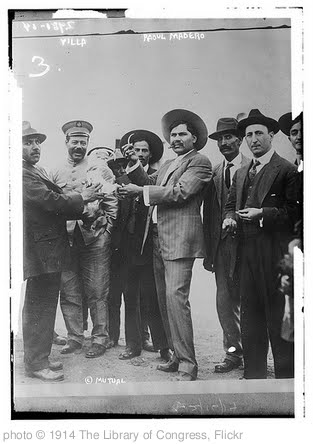January, 1915. Austro-Hungarian forces overrun and take the small country of Montenegro.
February 21, 1916. German guns fire on the French positions near the fort of Verdun in the beginning of a major assault on the French line. The French, who have concentrated their armies elsewhere along the front, retreat before the German onslaught.
March, 1916. The Austrian War Dog Institute and the German Association for Serving Dogs begin training dogs as guides for the blind.
 March 15, 1916. 4000 U.S. troops under the command of General John Pershing cross the border into Mexico in pursuit of Mexican rebel leader Pancho Villa. Villa and his Villistas have been raiding towns along the border in Arizona and New Mexico. Some say he is purposely trying to draw the Americans into the continued civil war in Mexico. The picture on the right is Pancho Villa and some of his men in 1914.
March 15, 1916. 4000 U.S. troops under the command of General John Pershing cross the border into Mexico in pursuit of Mexican rebel leader Pancho Villa. Villa and his Villistas have been raiding towns along the border in Arizona and New Mexico. Some say he is purposely trying to draw the Americans into the continued civil war in Mexico. The picture on the right is Pancho Villa and some of his men in 1914.
April 24, 1916. The Easter Rising. Irish nationalists in Dublin stage an uprising against British rule on the Monday after Easter Sunday. The Irish Republican Brotherhood and Sinn Fein, two nationalist organizations, lead the rebellion and attempt to declare Ireland to be an independent republic. The British government sends reinforcements to the army in Dublin to fight and capture the rebels.
May 31, 1916. British and German Dreadnoughts clash at Jutland off the coast of Denmark. Called the battle of Jutland, the fight ends in a German retreat but greater losses of men and ships for the British.
July 1, 1916. The Allies launch an attack on the German lines near the Somme River in northern France. Over 57,000 Allied soldiers and 800 Germans die in the first day of the offensive. The Battle of the Somme will end in November after more than a million deaths on both sides.
August, 1916. Romania, neutral until now, joins the Allies and invades Austria-Hungary.
September 15, 1916. Great Britain’s army reveals its new secret weapon: the tank. 32 tanks are deployed on the Somme, and German machine gunners scatter in their path. 2000 Germans are taken prisoner.
December, 1916. Cutex, the first liquid nail polish, is introduced in the U.S. by Northam Warren.
December, 1916. The ‘turnip winter’ in Germany and Austria sees food shortages caused by the Allied naval blockade and a high mortality rate among the civilian population.








